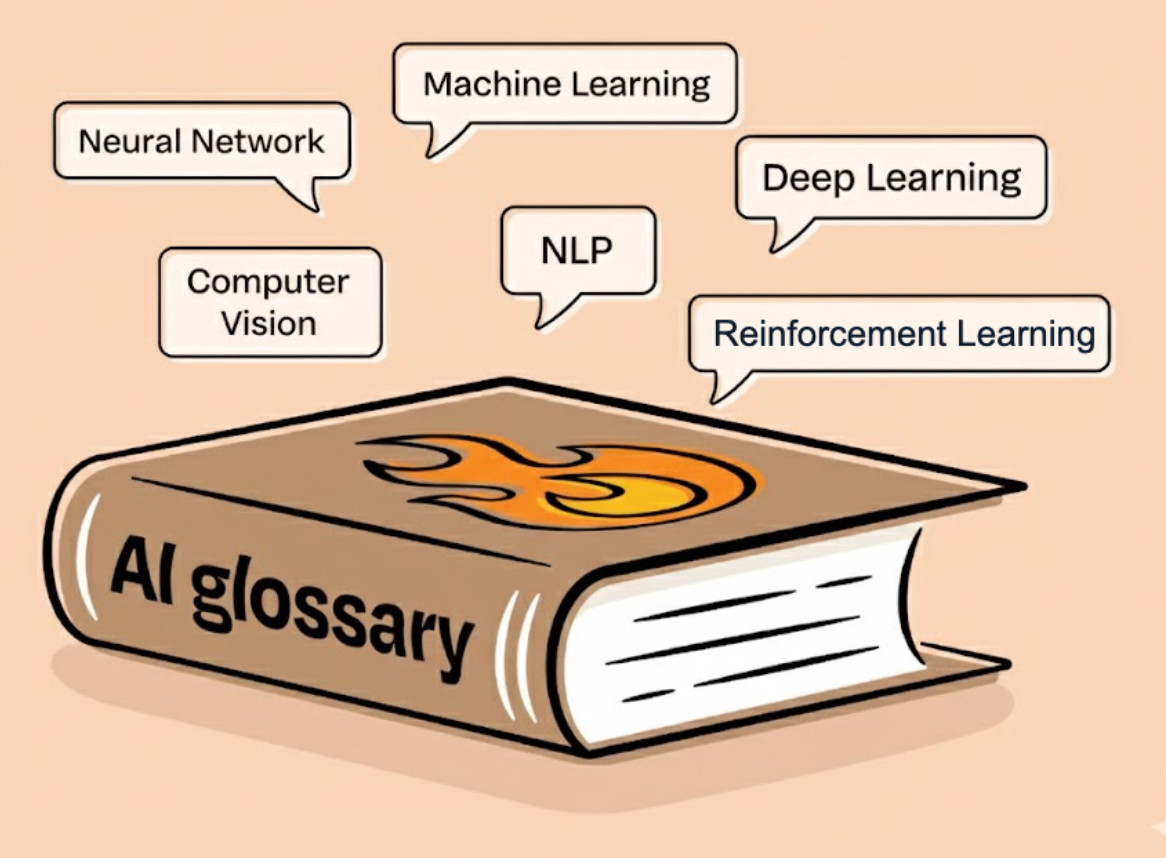AI Glossary: Top 20 AI Terms that You Should Know
|
|
Artificial Intelligence (AI) has rapidly evolved from a science fiction scenario to an everyday reality that permeates virtually every industry, delivering anywhere from better treatment options for cancer patients to smarter ways to serve popcorn. For AI professionals, students, and hobbyists alike, it is important to keep up with terminology after all, not only to understand research papers or industry news but also to have meaningful conversations around how AI is changing our world.
Let’s discuss the top 20 essential AI terms that form the foundation of conversations around AI today. Each section explains a term in detail, its relevance, applications, and the nuances that separate it from similar concepts.
| Key Takeaways: |
|---|
|

Artificial Intelligence (AI)
The ability of machines to perform tasks that would ordinarily require human intelligence is known as artificial intelligence (AI). Such systems can process data, identify patterns, make choices, and evolve without continual human input. AI consists of many subfields, such as machine learning, natural language processing, computer vision, and robotics. The end objective is to develop systems with reasoning, perception, and the ability to make decisions autonomously.
In the real world, AI is everywhere—from digital assistants like Alexa and Siri to recommendation systems on Netflix and YouTube. In healthcare, AI assists in diagnosing diseases by analyzing medical images, while in finance, it helps detect fraud in real time. Businesses use AI to automate workflows, predict customer behavior, and improve operational efficiency. Essentially, AI serves as the foundation for almost every smart system transforming industries today.
Read more: AI in Software Testing.
Machine Learning (ML)
Machine Learning (ML) is a branch of AI in which computer systems are able to learn and change from previous data without explicit coding. Instead of executing certain code, ML algorithms do pattern recognition and learn from examples in order to draw conclusions or make predictions based on historical data. This allows systems to increase in accuracy over time as more data comes in.
Machine Learning has a wide range of real-world use cases. Machine Learning systems are used by streaming platforms such as Netflix and Spotify to recommend content tailored to individual interests. E-commerce websites like Amazon make use of Machine Learning for product recommendations and dynamic pricing. In the finance industry, Machine Learning models study markets and signal abnormal operations for detecting fraudulent actions. It is this self-improving aspect that makes Machine Learning a part of today’s digital systems.
Read: Machine Learning Models Testing Strategies.
Deep Learning
Deep Learning is a subfield of machine learning that uses artificial neural networks with multiple layers to model and process complex representations of information. These networks replicate the structure of the human brain, enabling machines to read high-dimensional data, like images, audio and text. Deep learning is capable of feature extraction automatically, rather than the manual preprocessing associated with traditional data pre-processing methods.
In real life, deep learning has powered many practical advances in things like facial and voice recognition, language translations, autonomous driving and more. Tesla, for instance, uses deep-learning neural networks in its self-driving system to recognize and react to objects that appear along the road. In the medical industry, deep learning models help radiologists by detecting tumors precisely from medical images. Its precision in parsing vast amounts of data has become a driver behind innovations in AI.
Natural Language Processing (NLP)
Artificial intelligence, linguistics, and computation have together created natural language processing (NLP), which allows machines to apprehend (and communicate in) human language. The objective of NLP is to train computers to understand, decipher and make sense of human language in a manner that is valuable. Text classification, sentiment analysis, and machine translation are also some prominent NLP techniques.
In application, NLP empowers chatbots, translation devices, and virtual assistants to respond intelligently to user questions. NLP is used in website customer service bots to address frequently asked questions, thus decreasing response times and business costs. They also use NLP to analyze customer feedback and summarize long documents. By closing the chasm between man and machine, NLP has shaped how we use technology on a daily basis.
Read: Natural Language Processing for Software Testing.
Neural Networks
Neural networks are a class of artificial models mirroring the architecture of the human mind, with interconnected nodes (also referred to as neurons, for historical reasons) performing information processing. These neurons are organized into layers that convert input data into useful outputs through learning. There is a weight associated with each connection between neurons, which gets updated as the system learns from data so that it can fine-tune its predictions or classifications.
In practice, neural networks are heavily used to recognize images, synthesize speech, and predict the future. For instance, Google Photos employs neural networks to automatically organize and label photos by face identification. Banks use them to predict market trends and assess credit risks; voice assistants rely on neural networks to comprehend patterns of speech. Neural networks are so popular in part because their flexibility and scalability make them useful for nearly any kind of AI system imaginable.
Read: What is a Neural Network? The Ultimate Guide for Beginners.
Generative AI
Generative AI is a type of machine learning that creates unique, new content (text, images, videos, and music) from data patterns supplied by the user. In contrast to classic AI, which simply categorises or predicts things, generative AI produces never-before-seen stuff through a method called probabilistic modelling. This superpower is provided by sophisticated architectures such as Generative Adversarial Networks (GANs) and transformer-based models.
Generative AI includes examples like ChatGPT, which writes humanlike text, and DALL·E, which generates realistic images from text prompts. In fact, generative AI is already in use within industries to generate marketing content and simulate product designs or even create synthetic training data for other AI models. It’s changing the nature of work and offering the flexibility to work anywhere, anytime. But even with those dangers, it’s among the most exciting and fastest-growing areas in AI today.
Read: Generative AI in Software Testing.
Computer Vision
Computer Vision is the branch of AI that enables machines to interpret and understand visual data from the world. It involves training systems to identify objects, track movements, and interpret images or video feeds. This technology mimics human vision but can analyze visuals much faster and more consistently.
Computer vision has countless applications in real life, including recognition of faces in security camera footage or quality control checks on assembly lines. Tesla and Waymo also wanted to use it for self-driving cars, in which automobiles must recognize lanes, pedestrians, and traffic lights. In health care, computer vision is used to identify diseases from X-rays and MRIs, while retail companies use it to observe inventory levels. Its capability of analyzing visual data at scale makes it valuable in contemporary automation.
Read: Vision AI and how testRigor uses it.
Reinforcement Learning
Reinforcement Learning (RL) is a machine learning technique where an agent learns by interacting with an environment and its experience in the process. The agent is rewarded or penalized based on what kind of actions it takes and eventually learns the best strategy for achieving high reward. Reinforcement Learning models learn dynamically; they adapt to different environments and uncertainties.
A prominent instance of Reinforcement Learning is DeepMind’s AlphaGo, which learned how to beat human world champions in the board game Go. In robotics, Reinforcement Learning enables autonomous drones and robots to inhabit complex scenes. It is also employed in recommendation systems, portfolio optimization, and supply chain logistics. Its self-improving property also makes it suitable for problems that need adaptive and continual learning.
Large Language Models (LLMs)
Large Language Models (LLMs) are AI systems that have been trained on a lot of text data and taught to understand, generate, and reason using human language. These are models that leverage complicated neural architectures like transformers to understand context and generate grammatically correct text. They can write essays, summarize text passages and generate bits of computer code.
LLMs include OpenAI’s GPT-4, Anthropic’s Claude and Google’s Gemini. Businesses employ LLMs for automating customer service, generating marketing content and providing support for research or legal documents. They are used by developers to create code snippets and debug programs. As their contextual understanding gets better and better, LLMs are becoming the way that humans interact with intelligent software.
Read: What are LLMs (Large Language Models)?
Supervised Learning
Supervised Learning is a Machine Learning method where models are exposed to labeled datasets, that is, every input the algorithm sees has been tagged with a right answer. The system can be trained to associate inputs and outputs, and hence generalize predictions for new, unobserved data points. This method performs great when you have access to good enough labeled data.
Applications of the method in practice include spam filtering, credit scoring, and medical imaging classification. For example, an email filter that is trained on labeled “spam” and “not spam” messages sorts future emails into appropriate folders. Banks apply supervised learning to detect transactions susceptible to fraud. The model works well, but it is also resource-intensive in terms of human labor on annotating data and keeping the performance of the dataset.
Unsupervised Learning
Unsupervised Learning deals with data that doesn’t have predefined labels or outcomes. The system explores the data to find hidden patterns, relationships, or clusters without human supervision. It’s particularly useful for understanding complex, unstructured datasets.
One typical example is customer segmentation, in which companies categorize their customers by purchasing habits without any pre-determined classification. In cybersecurity, it can be used to find anomalies that may indicate fraud or network intrusions. It’s used in recommendation systems, genetics research, and natural language modeling. It discovers new relationships from raw data by revealing previously unknown structures.
Semi-Supervised Learning
Semi-Supervised Learning fills the gap between supervised and unsupervised learning. It makes use of little labeled data and a lot more unlabeled data for effective model training. This approach helps to save the cost and time of manually labeling with high accuracy.
Consider, for instance, medical image analysis, whereby expert-labeled scans are scarce while unlabeled ones abound. Semi-supervised models trained on both learn about the two to achieve robust diagnostic performance. It’s used in voice recognition, too: only small subsets of speech data are annotated. Semi-supervised learning is appealing for real-world applications with a few labeled examples due to its semi-supervised nature.
Transfer Learning
Transfer Learning enables a model trained on one task to leverage its knowledge on other related tasks. It requires less quantity of data as big datasets can be easily adapted from pre-trained models, and time to design and retrain new models is also saved. This is particularly useful when there is labeled data available for the new problem.
For example, a model created using millions of common images (such as dogs and cars) can be fine-tuned to detect medical anomalies in X-rays. In natural language processing (NLP), pre-trained models such as BERT or GPT are fine-tuned on domain-specific data from fields like finance or law. Transfer Learning reduces time to market, improves accuracy, and democratizes access to state-of-the-art AI models.
Bias in AI
Bias in AI is represented by algorithms that generate an unfair or biased outcome because of skewed or flawed training data. This can occur if datasets are biased in terms of a lack of representation or have historic biases. Such bias can result in discriminatory decisions in hiring, lending, and law enforcement.
Facial recognition systems, for instance, have been found to wrongly identify women and people of color at greater rates than they do white men. To this end, companies are turning to bias-detection frameworks and fairness-aware algorithms. Lowering AI bias improves not only the performance of models but also trust and accountability within AI-based systems.
Read: AI Model Bias: How to Detect and Mitigate.
Overfitting and Underfitting
Two common problems with model training are overfitting and underfitting. Overfitting takes place when the model learns numbers in training data so precisely that it also includes noise, hence it will perform poorly on new data. Underfitting occurs when the model is not complex enough to pick up those patterns.
For instance, a prediction model for stock cannot behave aggressively, training on its past behaviors and high-frequency operations. Developers choose regularization, dropout, and cross-validation to strike the balance between performance and generalization. Addressing these concerns guarantees that reliable AI systems are in practice.
AI Ethics
AI Ethics is concerned with the moral and social effects of artificial intelligence. It guarantees that AI systems act responsibly, transparently and in a way that doesn’t cause harm. Ethical principles cover fairness, accountability, privacy, and human supervision.
In practice, AI ethics matter when it comes to designing systems that affect human lives, such as hiring algorithms, autonomous vehicles or surveillance tools. For instance, companies must make sure that AI doesn’t discriminate or generate unsafe choices. Governments and institutions all over the world are defining principles to govern ethical AI, which makes human-centered design necessary.
Read: AI in Engineering – Ethical Implications.
Cognitive Computing
Cognitive Computing is a category of AI that simulates human thought processes in a computer model, including reasoning, memory, and problem-solving. It uses machine learning, analytics, and natural language processing to make sense of complicated information in context. Such systems are designed to enhance, but not replace, human intelligence.
A famous example is IBM Watson, which in healthcare is employed to scan medical literature and recommend treatment plans. Cognitive systems have also been increasingly applied in the business world to analyze unstructured data and provide insights for decision-making. Via the development of human-machine knowledge and allowing them to work together in a system, it enables productivity, which supports different sectors.
Read: Cognitive Computing in Test Automation.
Explainable AI (XAI)
The purpose of Explainable AI (XAI) is to ensure that the process by which an AI arrives at its conclusions is comprehensible to human users. It’s also a way to help users and regulators understand how models reach certain decisions, which runs up against the “black box” problem in deep learning. This is important in industries where interpretability by law or ethics is necessary.
For example, in health care, doctors need to know why an AI system is prescribing a given diagnosis. Banks also deploy XAI to explain a loan’s approval or denial to a customer. It also instills confidence between humans and artificial intelligence systems, as well as encourages adherence to policy regulations.
Read: What is Explainable AI (XAI)?
Data Mining
Data mining techniques are used to extract useful information and hidden patterns from very large databases using AI, mathematics, and database systems. It is frequently a precursor to creating predictive or analytical models. Methods like clustering, classification, and association rule mining extract patterns and relations.
For businesses in the retail sector, data mining is used to study customer purchasing patterns and inventory functions. In health care, it pinpoints disease outbreaks and patient risk factors. Banks utilize it for suspicious transactions, and telecoms use the tech to limit churn. Data mining converts raw data into meaningful insights that can drive business strategy.
Turing Test
The Turing Test (introduced by British mathematician Alan Turing in 1950) is a measure of the intelligence displayed by a machine. In the test, a human converses with both a machine and another human; if it’s difficult for the evaluator to tell which one is the machine, then you can say that artificial intelligence has passed.
While modern AI, such as ChatGPT and virtual assistants, show conversational fluency, they typically flunk the Turing Test’s more profound measure of understanding or reasoning. That being said, the test is still a symbolic moment for AI. It sets a goal for developers beyond mere intelligent behavior, towards actual machine cognition.
Conclusion
These top 20 AI terms center around artificial intelligence are crucial for anyone trying to interpret the ever-changing world of AI. From machine learning and deep learning, to ethics and explainability – we lay the groundwork for understanding how AI is influencing industries and our daily life. As technology marches ahead, the ability of professionals, students, and entrepreneurs to make informed decisions or create meaningful communication with intelligent systems at a human-level depends on understanding these terms.
In the end, learning ‘Talking to Robots’ is how we begin to author its responsible and transformative next chapter.
| Achieve More Than 90% Test Automation | |
| Step by Step Walkthroughs and Help | |
| 14 Day Free Trial, Cancel Anytime |












